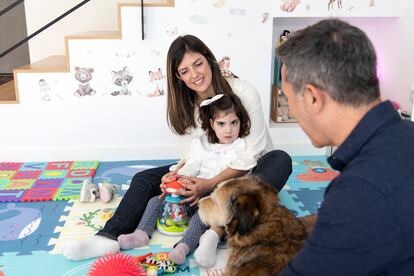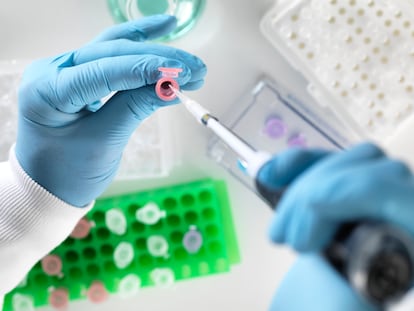Carmen, the girl who holds the key to the treatment of genetic diseases
A scientific and family crusade races against the clock using CRISPR and messenger RNA to find therapy for the little girl, who turned three years old, despite receiving a fatal prognosis when she was only three months old

Carmen was only three months old when, on Three Kings Day 2021, she was admitted to the hospital with convulsions, head nodding, labored breathing and blinking. The prognosis was dire: “She has six months to live.” Her father, Javier Silva, remembers the emptiness of the room, the dizziness, the pain that prevented him from thinking and moving. But Carmen has clung to life and she is now three years old. Her eagerness has led her parents to keep fighting and seek a minimum of hope in the world. And they found it in Ángel Carracedo, the director of the Galician Public Foundation of Xenomic Medicine, in Spain, and in the Center for Research in Molecular Medicine and Chronic Diseases (CIMUS). They have learned that the origin of the disease that has Carmen 94% disabled is an unusual mutation and have found two possibilities for treatment: gene editing and messenger RNA. Carmen and millions of people whose lives have been cut short by an error in the information on which life is built depend on these alternatives.
The little girl lives in Benalmádena (Málaga), Spain, with her parents, Javier, 51, and Laura Bergillos, 38. Since the first diagnosis, epileptic and developmental encephalopathy with malignant migratory focal seizures — known as “malignant epilepsy of infancy” — they have been dedicated to her. “We set up a hospital at home, and I learned to be my daughter’s nurse,” Laura recalls, fresh from a stimulation therapy session that she replicates daily. The little girl’s maternal grandparents are part of the permanent care team.
Carmen cannot control her muscles and can barely hold her head up for a few seconds. Her parents and grandparents serve as her arms and legs, and she has a standing frame, a device similar to a highchair that allows her to remain upright. She eats through a gastric button due to dysphagia (difficulty or absolute inability to swallow) and is unable to speak. But smiles flood the house, it’s a home full of light and color that exudes what Javier calls the main treatment: “affection.”

Carmen’s seizures have been reduced to one a day (“she had 50 every 24 hours,” Laura recalls) with that medicine, two daily antiepileptic drugs and a new ketogenic diet (high in fat, low in carbohydrates and moderate in proteins), which is complementary and temporary due to its long-term side effects. The little girl is showing small functional advances. But the solution is more complex: attacking the original cause, the error in the genetic coding of GABRB3, which prevented Carmen’s normal development from the embryonic stage.
Carracedo, one of the world’s leading geneticists, is a professor at the University of Santiago de Compostela in Spain (he is passionate about teaching) and the co-director of the Center for Biomedical Research Network on Rare Diseases. When he heard Carmen’s story, he did not hesitate to get involved in the case. “It is a spectacular family in every sense: fighters and brave people who are dedicating their lives to the girl,” he emphasizes.
“The mutation in Carmen’s GABRB3 gene makes it non-functional and generates a series of problems: not only epilepsy, but also hypotonia [muscle weakness], neurosis and neurodevelopment,” explains Carracedo. Only about 20,000 genes encode proteins, 1% of the total human genome. Many are synapse genes, for neuron connections, and this is one of them.
“Carmen’s mutation is unique, but there are other people with mutations in this gene. It is a rare disease, ultra-rare, if you analyze only the occurrence in the population, but all together they account for 8% of all diseases. It is not trivial. There are many, many people who absolutely have similar problems with other genes,” adds Carracedo.
This is key to the race against the clock being undertaken by all those around the little girl. According to the Spanish Federation of Rare Diseases (FEDER), in Spain three million people suffer from such illnesses (400 million in the world) and diagnosis is delayed between four and 10 years. Juan Carrión, the president of FEDER, estimates that “over 70% are genetic in origin and two out of three appear in childhood.” Hence, the door that has been opened for Carmen in terms of the diagnostic protocol and possible treatment is also open for thousands of other people.
But the strategy is complex. In a very basic way, gene therapy consists of identifying the gene and the mutation causing the problem, eliminating the defective part of the chain and replacing it with a correct part so that it can function again thanks to the technique known as CRISPR. Emmanuelle Charpentier and Jennifer Doudna developed this technique based on the research of the Spanish microbiologist Francis Mojica and won the Nobel Prize in 2020. In Carmen’s case, the situation is much more complicated.
Researcher Catarina Allegue’s team at the University of Santiago de Compostela (USC) Center for Research in Molecular Medicine and Chronic Diseases analyzed the entire exome (part of the genome formed by the exons, the coding parts of the genes) to reach GABRB3, whose mutation was already described as pathogenic.
Given the impossibility of reaching the precise point in Carmen’s brain, scientists resort to tissue or pluripotent stem cells from the blood, those with the ability to form all of the body’s cells. These show a map of the little girl’s neurons and, compared with control models, indicate the specific mutation.
The same cells make it possible to reconstruct an organoid, a tissue similar to Carmen’s brain. “This gives us much more global information because we don’t have the neurons separately, but we have all the groups interacting with each other,” explains Allegue.
This complex model has been fundamental because it has provided the key to one of the treatment strategies. “In Carmen’s case, we found that the GABRB3 gene is expressed very little, both in the organoid and in the control organ (the model of how it should be), from the early stages of development. After 15, 30 or 45 days, very little or practically nothing is expressed. We deduce that it is a gene that acts early in embryonic development, but then it is no longer needed.”

Thus, the research hypothesis is that the damage in Carmen occurred at an early stage and that, given the almost null expression of the gene after those primary phases of development, modifying GABRB3 would be useless. “Even if we send a CRISPR to try to repair that mutation, if that gene is no longer being expressed, if it is no longer giving rise to proteins because it is no longer needed, we are not going to reverse anything,” the researcher summarizes.
That finding forces them to rethink the strategy. The target is not only the original gene but also those that should have been influenced in the early embryonic stages. “The genes interact with each other in pathways, and we can identify another gene we can act on in these, which could be a potential therapeutic target,” explains Allegue. In order to find out the levers that need to be modified, starting from the brain organoid, they have already begun a study of Carmen’s proteome, the complete set of proteins that cause the coding genes to overexpress those affected by the original dysfunction of GABRB3.
Another of the complexities of this unexplored scientific quest is how to deliver the genetic modifications to the exact site in the brain. In this regard, they are testing in the organoid with lipid nanoparticles developed by a USC spin-off company and with adenoassociates generated by a group from Navarra. The latter vehicle is a specific virus for the target tissue (brain tissue, in Carmen’s case) that acts as a messenger to carry the repaired part and the tools to replace the damaged one. For each of the systems, they already have two candidates with promising results.
At the same time, the Galician team is investigating the possibility of a treatment based on messenger RNA, which enabled the development of the vaccine against Covid. From the genetic information of DNA, RNA generates the proteins that perform critical functions in the body. The goal is to design ribonucleic acid with the precise instructions for Carmen’s cells to manufacture the proteins she needs.
In this complicated crusade, time is running out and resources are scarce. Gene and RNA therapies are now the only options for Carmen and for those with similar diseases. Her treatment can establish a guide for tackling pathologies of similar origin for the first time anywhere in the world. There is no other option and there is no time to lose. They need resources, funding and cases that can serve as a mirror for Carmen’s pathology and provide data to complete the research.
Laura has played a fundamental role in this regard. She has contacted many people in search of similar cases and continues investigating breakthroughs in this field on her own. She has established a social network of parents with similar problems and has become involved with Cure GABA, an NGO founded in the United States to promote research and the study of diseases and effective treatments for genetic disorders affecting GABA, the general term for the neurotransmitter affected by mutations.
This organization’s work has led to cooperation with a Danish group that is already experimenting on mice. Their results are crucial for accelerating the tests and the approval of Carmen’s therapy, which will not be ready for at least six months.
But the objective is clear. None of the parties involved will stop, even though no one can guarantee the results. It will be the first time it is applied in a case like Carmen’s, but the results will be useful not only for her, but for all those who suffer from illnesses caused by an error in genetic coding.
Sign up for our weekly newsletter to get more English-language news coverage from EL PAÍS USA Edition
Tu suscripción se está usando en otro dispositivo
¿Quieres añadir otro usuario a tu suscripción?
Si continúas leyendo en este dispositivo, no se podrá leer en el otro.
FlechaTu suscripción se está usando en otro dispositivo y solo puedes acceder a EL PAÍS desde un dispositivo a la vez.
Si quieres compartir tu cuenta, cambia tu suscripción a la modalidad Premium, así podrás añadir otro usuario. Cada uno accederá con su propia cuenta de email, lo que os permitirá personalizar vuestra experiencia en EL PAÍS.
¿Tienes una suscripción de empresa? Accede aquí para contratar más cuentas.
En el caso de no saber quién está usando tu cuenta, te recomendamos cambiar tu contraseña aquí.
Si decides continuar compartiendo tu cuenta, este mensaje se mostrará en tu dispositivo y en el de la otra persona que está usando tu cuenta de forma indefinida, afectando a tu experiencia de lectura. Puedes consultar aquí los términos y condiciones de la suscripción digital.
More information
Últimas noticias
Iranian women are also defying the taboo of riding motorcycles (and without a license)
David Bowie, the galactic thinker who encouraged us to break new ground
John Berger and the loss of rural culture
From police officer to bloodthirsty kidnapper: Terror in Mexico during the years of ‘The Ear Chopper’
Most viewed
- David King, chemist: ‘There are scientists studying how to cool the planet; nobody should stop these experiments from happening’
- Reinhard Genzel, Nobel laureate in physics: ‘One-minute videos will never give you the truth’
- Oona Chaplin: ‘I told James Cameron that I was living in a treehouse and starting a permaculture project with a friend’
- Mexico completes its trade shift with the entry into force of tariffs on China and countries without trade agreements
- Sinaloa Cartel war is taking its toll on Los Chapitos











































